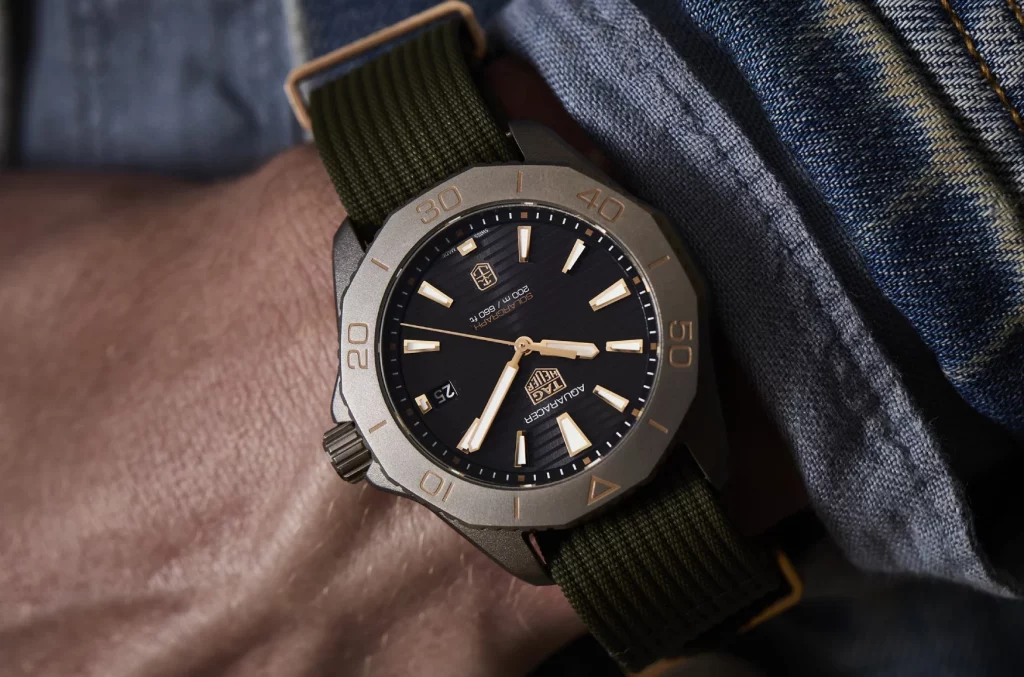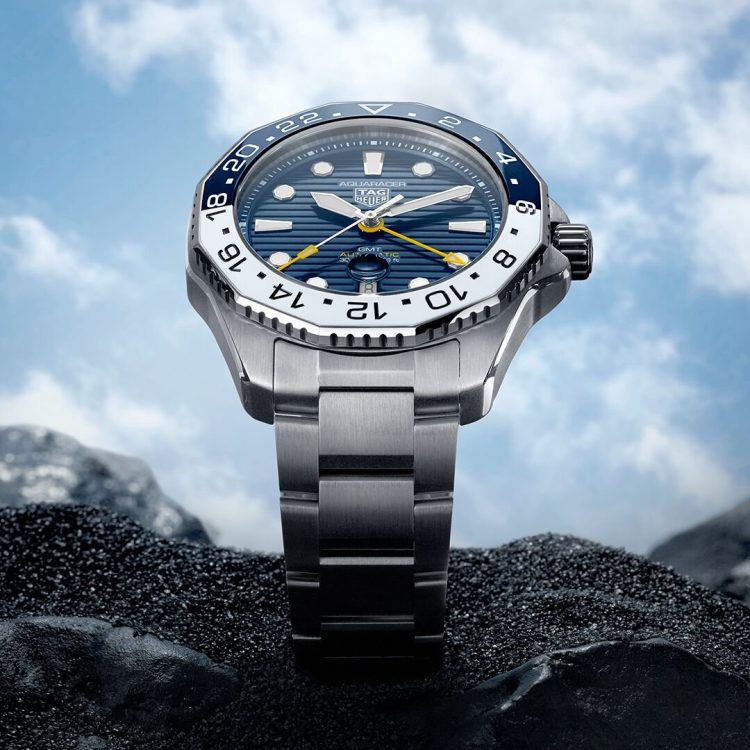Introduction
TAG Heuer is a name synonymous with Swiss luxury and precision timekeeping. Founded in 1860 by Edouard Heuer in the Jura Mountains of Switzerland, the brand has consistently stood at the forefront of watchmaking innovation. From the development of the first chronograph to its partnerships in motorsports, TAG Heuer has shaped not only the luxury watch industry but also the field of sports timing. This article delves deeply into the craftsmanship and cutting-edge technologies that have made TAG Heuer a dominant force in the watchmaking world.
Chapter 1: TAG Heuer’s Philosophy of Craftsmanship
1.1 Swiss Watchmaking Tradition
Swiss watches are renowned for their precision, reliability, and craftsmanship. TAG Heuer, deeply rooted in this tradition, blends traditional watchmaking skills with modern technology. At the heart of the brand’s craftsmanship is the use of high-quality materials and innovative manufacturing techniques, making TAG Heuer a leader in both luxury and performance timepieces.
TAG Heuer’s commitment to precision is evident in the fact that they’ve often set benchmarks for others in the industry. The Heuer-01 movement, for instance, is a testament to their Swiss craftsmanship, offering high performance while maintaining TAG Heuer’s signature design aesthetics.
1.2 Quality Materials and Fine Finishing
The choice of materials in TAG Heuer watches contributes significantly to their performance and aesthetics. The brand uses stainless steel, titanium, ceramics, gold, and diamonds to craft durable yet sophisticated timepieces.
- Stainless Steel: Known for its corrosion resistance, strength, and shine, it is commonly used in cases, bracelets, and bezels.
- Titanium: Used in some of TAG Heuer’s sportier models (such as the Formula 1 series), titanium is favored for being lightweight yet highly durable.
- Ceramics: Ceramics, particularly in bezels, are used for their scratch resistance and ability to maintain a pristine look over time. TAG Heuer’s use of ceramic in its Monaco and Carrera lines has been praised for its aesthetic and durability.
1.3 In-House Movements
One of TAG Heuer’s greatest achievements in watchmaking is the development of in-house movements. Although TAG Heuer initially relied on third-party movements, they made significant strides in the 1960s by developing their own chronograph movements. The Caliber 11, released in 1969, was the first automatic chronograph movement to be integrated into a watch.
- Caliber 16: A key movement in the Carrera line, this automatic chronograph is celebrated for its precision and reliability.
- Heuer 01: The Heuer 01 is a modular movement that offers a skeletonized dial and excellent performance with a power reserve of 50 hours. TAG Heuer’s creation of this movement highlights the brand’s mastery of both mechanical and aesthetic innovations.
Chapter 2: Technological Innovations – Pushing the Boundaries
2.1 Chronograph Technology – Precision Timing for Every Activity
TAG Heuer’s reputation for chronograph technology stems from their expertise in precision timing. Chronographs are integral to the brand’s identity, and TAG Heuer has consistently advanced the technology behind these high-performance timepieces.
- First Automatic Chronograph: TAG Heuer revolutionized watchmaking with the introduction of the Caliber 11, the world’s first automatic chronograph movement, which was a groundbreaking achievement in 1969.
- Superquartz Technology: TAG Heuer’s Formula 1 collection features quartz movements with Superquartz technology, which offers ten times the accuracy of traditional quartz movements. This advanced technology has been praised for its precision and stability.
2.2 The Monaco V4 – The World’s First Belt-Driven Watch
One of TAG Heuer’s most innovative creations is the Monaco V4, a watch powered by belt-driven technology rather than traditional gears. Launched in 2009, this watch uses a linear mass and four micro-belts to drive the timekeeping mechanism, showcasing TAG Heuer’s commitment to pushing the limits of traditional watchmaking.
The Monaco V4 is an engineering marvel that combines classic design elements with futuristic technology, and its patented movement has attracted praise from watch enthusiasts and collectors for its uniqueness.
2.3 Smartwatch Technology – TAG Heuer Connected
In response to the growing demand for smartwatches, TAG Heuer introduced the TAG Heuer Connected series. Combining Swiss watchmaking expertise with state-of-the-art technology, the Connected series merges traditional craftsmanship with smart technology.
- The TAG Heuer Connected smartwatch features a high-resolution touchscreen with Google’s Wear OS, enabling users to access fitness tracking, notifications, and other smart features while maintaining the elegance and durability that TAG Heuer is known for.
TAG Heuer’s decision to incorporate smartwatch features in its product line positions it as a brand that embraces innovation while remaining committed to its heritage of luxury craftsmanship.

Chapter 3: The Aesthetics and Design Philosophy of TAG Heuer Watches
3.1 Iconic Collections – Design at Its Finest
TAG Heuer is well-known for producing watches that not only perform at the highest level but also look visually striking. The brand’s design philosophy is built around creating watches that are timeless, functional, and aesthetically pleasing. Several TAG Heuer collections have become icons in the world of horology:
- Carrera: Inspired by the world of motorsports, the Carrera collection features clean lines, a chronograph function, and a sporty aesthetic. It’s a design that balances elegance with functionality, making it suitable for both formal events and sports activities.
- Monaco: A true symbol of the brand, the Monaco collection is known for its square case and retro appeal. The Monaco is particularly famous for its association with Steve McQueen in the movie Le Mans, making it one of the most recognizable watches in history.
- Formula 1: Designed with the racing world in mind, the Formula 1 collection features bold designs and robust functionality, with a focus on durability and water resistance.
3.2 The Importance of Skeleton Dials
One of TAG Heuer’s signature design elements is the use of skeleton dials, especially in their Heuer 01 series. This design choice allows users to see the inner workings of the watch, creating a sense of transparency and connection between the mechanical movement and the wearer.
The skeleton dial is not only visually captivating but also represents TAG Heuer’s commitment to showcasing the artistry behind watchmaking. By allowing the user to observe the movement in action, TAG Heuer adds a layer of intrigue to its timepieces.
Chapter 4: Durability and Performance – Built to Last
4.1 Robust Build for Sports and Adventure
TAG Heuer watches are designed to withstand the toughest conditions, making them particularly appealing to athletes and outdoor enthusiasts. The brand’s affiliation with Formula 1 racing and motorsports has influenced the creation of timepieces that are engineered to handle extreme conditions.
- Water Resistance: Many TAG Heuer models are equipped with impressive water resistance capabilities. The Formula 1 series, for example, offers water resistance up to 200 meters, making them suitable for swimming and diving.
- Shock Resistance: TAG Heuer’s watches are also built to handle shock and impact, ensuring they remain functional even under strenuous conditions.
4.2 Longevity and Maintenance
In addition to durability, TAG Heuer watches are also known for their longevity. Many users report that their watches continue to perform flawlessly for years, with only occasional servicing required. The brand’s commitment to precision ensures that every watch, whether automatic or quartz, maintains accurate timekeeping for an extended period.
Regular maintenance is important to preserve the functionality of TAG Heuer watches. The brand recommends servicing every 3 to 5 years, which ensures that the watch remains in peak condition and maintains its aesthetic charm.
Chapter 5: The Future of TAG Heuer – Innovation and Sustainability
5.1 Embracing Sustainability
In recent years, TAG Heuer has placed a stronger emphasis on sustainability. The brand has begun integrating
eco-friendly practices into its production processes, such as the use of recycled materials and more energy-efficient manufacturing methods.
For example, TAG Heuer has explored using recycled stainless steel in some of its watches, as well as packaging made from sustainable sources. This commitment to sustainability ensures that TAG Heuer’s legacy of innovation continues to evolve with modern sensibilities.
5.2 Continued Innovation in Watchmaking
TAG Heuer has always been at the forefront of watchmaking technology, and its future is likely to involve continued advancements in both mechanical and smart technology. The integration of AI, wearable tech, and advanced materials is expected to play a large role in the brand’s upcoming collections.
With their strong foundation in precision, aesthetics, and durability, TAG Heuer will likely continue to produce groundbreaking watches that marry luxury with cutting-edge technology.
Conclusion: TAG Heuer – A Brand of Craftsmanship and Technological Mastery
TAG Heuer has carved a unique niche in the world of luxury watches, fusing Swiss craftsmanship with state-of-the-art technology. The brand’s history of innovation and commitment to performance have earned it a place at the top of the watchmaking industry.
Whether you are an athlete, a motorsport enthusiast, or simply someone who appreciates timeless design, TAG Heuer offers a range of timepieces that blend elegance, precision, and cutting-edge technology. As the brand moves into the future, its legacy of craftsmanship and innovation will undoubtedly continue to influence the world of horology for years to come.





































